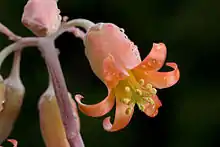Cotyledon orbiculata
Cotyledon orbiculata, commonly known as pig's ear or round-leafed navel-wort, is a South African succulent plant belonging to the genus Cotyledon.
| Cotyledon orbiculata | |
|---|---|
 | |
| Scientific classification | |
| Kingdom: | Plantae |
| Clade: | Tracheophytes |
| Clade: | Angiosperms |
| Clade: | Eudicots |
| Order: | Saxifragales |
| Family: | Crassulaceae |
| Genus: | Cotyledon |
| Species: | C. orbiculata |
| Binomial name | |
| Cotyledon orbiculata | |
| Synonyms | |
|
Cotyledon elata | |
Description
Cotyledon orbiculata is an extremely variable species that grows to approximately 1.3 m (4.3 ft) in height.[1] It has gray-green leaves that can be up to 13 by 7 cm (5.1 by 2.8 in) with a white powdery substance on them that helps reflect sunlight and conserve water.[2] The shape of the leaves was thought to have a resemblance to a pig's ear, thus the common name.[3]
The bell-shaped flowers are small, usually less than 3 cm (1.2 in) in length, and droop from the top of a 60 cm (24 in) tall stalk.[1] The flowers are usually orange-red but yellow varieties also exist. The tubular flower crown has no bulges and is 20 millimeters long and up to 9 millimeters in diameter. The bent back crown tips are orange, red or yellow and are 12 millimeters long. The stamens protrude 2 to 3 millimeters. The yellow anthers are elongated and 1.75 millimeters in diameter. The slightly transversely elongated nectar scales are dull and yellowish green and are 1.5 × 2 millimeters in size. The 10 stamens are attached to the base of the corolla (2 per petal), and the 5 carpels each have a style longer than the ovary.
 Flower
Flower.jpg.webp) Leaves (green variety)
Leaves (green variety) Grey variety in cultivation
Grey variety in cultivation
Varieties and cultivars
This diverse species includes a large number of varieties and cultivated forms (which some may have a resemblance to Kalanchoe thyrsiflora).[4][5]
Recognised varieties include:
- Cotyledon orbiculata var. flanaganii (Schönl. & Baker f.) Toelken, with elongated leaves in whorls
- Cotyledon orbiculata var. oblonga (Haw.) DC., defined by its red leaf-margins and 20–50 cm inflorescence
- Cotyledon orbiculata var. spuria (L.) Toelken, defined by having (2–)3–5 bract pairs on the stem of its inflorescence.
Other forms include:
- Cotyledon orbiculata var. "Dactylopsis", a small and proliferous plant with elongated, terete leaves.
- Cotyledon orbiculata var. "Engleri" (= cultivar: "Viridis"), with leaves of a deep and slightly glaucous green
- Cotyledon orbiculata var. "Mucronata", defined by its mucronate leaves.
- Cotyledon orbiculata var. "Oophylla" Dinter (= cultivars: "Boegoeberg" and "Lizard Eggs"), defined by its round, white, pruinose leaves.
- Cotyledon orbiculata var. "Undulata" Haw. (= cultivar: "Silver Crown"), defined by its wide, flat, round leaves with bent margin.
- Cotyledon orbiculata f. "Takbok", with leaves that often have multiple lobes, becoming antler-like.
 Cotyledon orbiculata is a common garden plant, with many different varieties. The antler-like leaves of the "Takbok" form can be seen on the left for example.
Cotyledon orbiculata is a common garden plant, with many different varieties. The antler-like leaves of the "Takbok" form can be seen on the left for example. "Engleri", with its deep glaucous-green leaves.
"Engleri", with its deep glaucous-green leaves..jpg.webp) var. flanaganii often has its elongated leaves in whorls of three.
var. flanaganii often has its elongated leaves in whorls of three. var. oblonga, a cultivar known as "Grey Sticks".
var. oblonga, a cultivar known as "Grey Sticks". "Oophylla" has round, white, pruinose leaves.
"Oophylla" has round, white, pruinose leaves. "Shireen" form.
"Shireen" form. var. spuria
var. spuria
Distribution
Native to South Africa,[1] it is popular in gardens in many countries. In the wild, it grows naturally in rocky outcrops in grassy shrubland and the Karoo region. In New Zealand, it is considered an invasive plant and is listed on the National Pest Plant Accord.[6]
Uses
Cotyledon orbiculata has a number of medicinal uses. In South Africa, the fleshy part of the leaf is applied to warts and corns. Heated leaves are used as poultices for boils and other inflammations. Single leaves may be eaten as a vermifuge and the juice has been used to treat epilepsy.[2]
However, the leaves contain a bufanolide called cotyledontoxin, which is toxic to sheep, goats, horses, cattle, poultry, and dogs, causing a condition known as cotyledonosis.[7]
References
| Wikimedia Commons has media related to Cotyledon orbiculata. |
- "Cotyledon orbiculata". University of Oklahoma Department of Botany & Microbiology. June 13, 2009. Retrieved 2010-04-19.
- Harris, Shireen. "Cotyledon orbiculata". South Africa National Biodiversity Institute. Retrieved 2010-04-19.
- Vandecasteele, Petra; Godard, Paul (2008). In Celebration of Fynbos. Struik. pp. 54–55. ISBN 978-1-77007-490-3.
- Cotyledon orbiculata PlantZAfrica.com
- HR. Tölken (1985). Crassulaceae. In O.A. Leistner, Flora of southern Africa 14. Botanical Research Institute, Pretoria.
- "National Pest Plant Accord" (PDF). Ministry of Agriculture and Forestry. 2008. Archived from the original (PDF) on 2008-10-15. Retrieved 2010-04-19.
- Wickens, G. E. (1998). Ecophysiology of economic plants in arid and semi-arid lands. Springer. p. 204. ISBN 3-540-52171-2.
